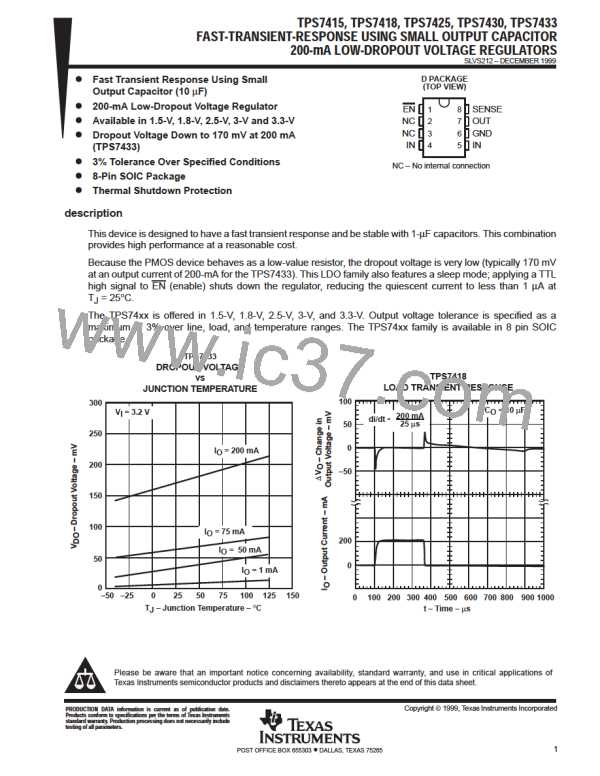TPS7415, TPS7418, TPS7425, TPS7430, TPS7433
FAST-TRANSIENT-RESPONSE USING SMALL OUTPUT CAPACITOR
200-mA LOW-DROPOUT VOLTAGE REGULATORS
SLVS212 – DECEMBER 1999
APPLICATION INFORMATION
The TPS74xx family includes five voltage regulators (1.5 V, 1.8 V, 2.5 V, 3 V, and 3.3 V).
minimum load requirements
The TPS74xx family is stable even at zero load; no minimum load is required for operation.
SENSE terminal connection
TheSENSE terminal must be connected to the regulator output for proper functioning of the regulator. Normally,
this connection should be as short as possible; however, the connection can be made near a critical circuit
(remote sense) to improve performance at that point. Internally, SENSE connects to a high-impedance
wide-bandwidth amplifier through a resistor-divider network and noise pickup feeds through to the regulator
output. Routing the SENSE connection to minimize/avoid noise pickup is essential. Adding an RC network
between SENSE and OUT to filter noise is not recommended because it can cause the regulator to oscillate.
external capacitor requirements
An input capacitor is not usually required; however, a ceramic bypass capacitor (1 µF or larger) improves load
transient response and noise rejection if the TPS74xx is located more than a few inches from the power supply.
A higher-capacitance electrolytic capacitor may be necessary if large (hundreds of milliamps) load transients
with fast rise times are anticipated.
Like all low dropout regulators, the TPS74xx requires an output capacitor connected between OUT and GND
to stabilize the internal control loop. The minimum recommended capacitance value is 1 µF and the ESR
(equivalent series resistance) must be at least 300 mΩ. Solid tantalum electrolytic and aluminum electrolytic
are all suitable, provided they meet the requirements described previously.
TPS74xx
4
5
8
7
SENSE
OUT
SENSE
V
IN
IN
I
V
O
1
1 µF
EN
C
O
+
1 µF
GND
6
ESR
Figure 20. Typical Application Circuit
regulator protection
The TPS74xx PMOS-pass transistor has a built-in back diode that conducts reverse currents when the input
voltage drops below the output voltage (e.g., during power down). Current is conducted from the output to the
input and is not internally limited. When extended reverse voltage is anticipated, external limiting may be
appropriate.
11
POST OFFICE BOX 655303 • DALLAS, TEXAS 75265

 TI [ TEXAS INSTRUMENTS ]
TI [ TEXAS INSTRUMENTS ]